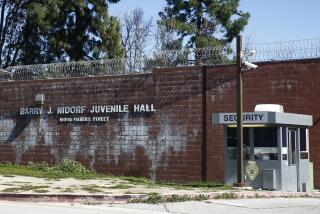Children, Crime and the County Budget : Parks: Recreation is a cost-effective way to strengthen families and communities.
- Share via
At public hearings on the Los Angeles County budget crisis, a young Latino thanked the county for a park and a library near his home in San Fernando, crediting recreation directors and librarians for helping him develop a commitment to learning. Last month, he graduated from medical school, and his promise to the Board of Supervisors was a life of service to others.
We were reminded of another boy who some 60 years earlier used a South-Central park to run. A track scholarship to UCLA started a public-service career that was recently concluded when Tom Bradley retired after 20 years as mayor.
Those are two of many thousands of stories in which public parks and recreation have helped to nurture our youngsters into manhood and womanhood.
As the supervisors struggle with painful decisions, county parks and recreation are among the potential big losers. The only “winners” appear to be the Sheriff’s Department and the District Attorney’s office. Twenty-four county parks and 20 swimming pools are proposed to be closed, and the entire 150 full-time and part-time recreation staff eliminated.
The relationship between recreation and crime is synergistic. A recent Carnegie report noted that “youth have an average of five hours of discretionary time a day and many are falling victim to negative recreation--gang-banging, drugs, sex, tagging and crime.” The violent crime rate continues to escalate, despite law enforcement’s repeated promises to “get tough.” Between 1980 and 1992, California engaged in an orgy of criminal-justice spending, including $4 billion for construction of 13 new prisons, with another six in the pipeline. Nevertheless, gangs and gang membership in Los Angeles doubled in the five years from 1986 to 1991. It is instructive that most violent crime is committed by those between 14 and 19 and the average entry age into state prison is 27.
More money should be redirected to early crime-prevention programs, including recreation, which can do more than anything else to reduce crime. In June, 1992, 150 criminal-justice leaders from around the country--including prison officials, governors, attorney generals, prosecutors, police chiefs, academics and legislators--signed a statement criticizing the “lock ‘em up” approach. They urged public officials to be more honest about the failure of prisons to control crime and the enormous financial burdens of building and operating prisons. In a recent RLA-commissioned poll, 1,000 adults who live in the riot zone identified recreation and youth services as the overwhelming top priority for government. Six months after the worst civil disturbance in our nation’s history, and during a three-year recession in which thousands have lost their jobs, 64% of county voters supported the People for Parks-sponsored Proposition A, which made $540 million available for park and recreation facilities and improvements throughout the county. It makes little sense now to gut the park system of money to support recreation programming.
Recreation strengthens children, families and communities in a cost-effective way. Detroit’s restitution recreation (parolees working with recreation directors), Toronto’s coed homeless softball and Los Angeles’ late-night basketball (gang youth playing from 10 p.m. to 2 a.m.) are a few examples of successful police and community-service recreation programs.
Los Angeles’ children need creative solutions, not cataclysmic cuts in recreation and parks. It’s time for all the mayors, teachers, carpenters, athletes and others who have benefited from parks to join our young doctor and speak up.
More to Read
Sign up for Essential California
The most important California stories and recommendations in your inbox every morning.
You may occasionally receive promotional content from the Los Angeles Times.










